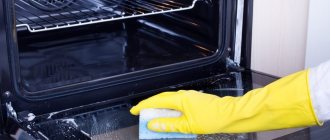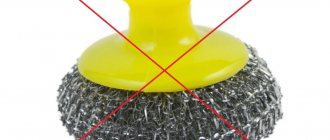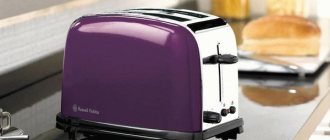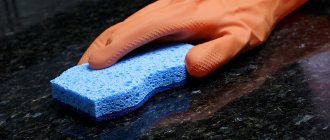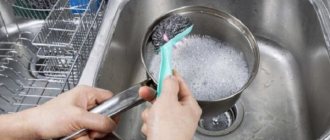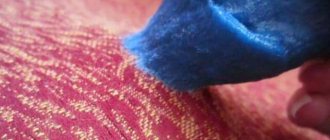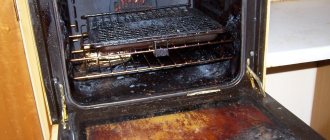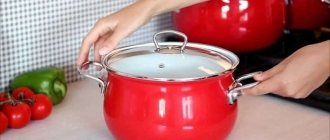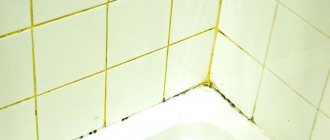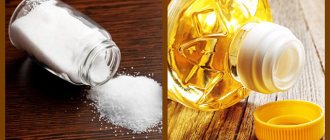The glass ceramic induction hob looks stylish and fits perfectly into the modern kitchen interior. Its additional advantages include instant, uniform heating and rapid cooling. Within a few minutes after switching off, you can touch it without fear. But caring for such a surface has many features: for example, it gets dirty quickly, and cleaning cannot be put off until “later.” To clean a glass-ceramic stove from burnt food and not harm it, you need to know a few rules and use special tools.
Rules for caring for glass ceramics
It is best to clean the glass-ceramic surface every day after use - old stains with stains are more difficult to remove.
How to carry out the procedure:
- First of all, unplug the device.
- Wait for the stove to cool completely to avoid cracks due to temperature differences between the surface and the detergent.
- Get a separate soft sponge or cloth for cleaning; use it only for the stove.
- Use only soft, clean fabrics - the glass-ceramic coating is easily scratched, causing it to lose its shine.
- After cleaning, wipe with a damp cloth, remove any remaining water with paper napkins, as even they can leave marks.
- It is advisable not to use the device for at least half an hour so that it dries completely.
- To add shine, apply glass cleaner and polish with a soft cloth.
- Try not to touch the glass ceramics with your fingers - there will be fingerprints that will also have to be wiped off.
Advantages and disadvantages compared to traditional cleansing methods
If once upon a time chemical detergents were considered terrible, now almost every housewife uses them, thereby keeping their home perfectly clean. There is a huge selection of household chemicals on the market, and they all have their advantages and disadvantages.
- cleaning surfaces does not take much time;
- affordable price;
- high cleaning efficiency;
- safe composition, both for surfaces and for the environment.
- require careful handling.
What will you need for cleaning?
It is best to clean capricious glass ceramics with special care products. Along with this, it is recommended to purchase:
- A soft sponge or microfiber cloth.
- A special scraper with a thin blade. Use it to clean off carbon deposits or grease deposits.
- Melamine sponge. It will also come in handy, as it can easily clean even difficult stains, making cleaning much easier.
Method 2. How to clean a glass-ceramic stove with soda
We would like to warn you right away: all manufacturers prohibit the use of soda for washing glass ceramics due to its abrasive properties (micro scratches remain on the surface, due to which the shine is somewhat lost). However, as practice shows, soda does not cause significant harm, and most users use it to wash glass ceramics regularly. If your stove is very dirty and you don't have anything on hand, you can try this cleaning method.
Due to its alkaline properties, it copes well with old carbon deposits, dirt and grease.
- Sprinkle baking soda over the entire surface of the stove.
- In a small bowl, prepare a solution of hot water and dishwashing liquid.
- Soak a towel thoroughly in the soapy solution and completely cover the stove with it as shown in the photo.
- Leave the towel on for 15-30 minutes to loosen stains.
- Rub the surface of the stove with the same towel, using the remaining soda as a tool against soot and dirt.
- Wash and wipe the glass ceramics thoroughly and dry. If desired, use 9% vinegar to remove baking soda residue faster.
- Instead of one large towel, you can use two small ones.
- The towel should be wet enough to dissolve the baking soda and wet the surface, but not so wet that puddles form and water runs off the stove.
- This cleaning method can be used immediately after method No. 3 (see below) - this will make cleaning even more effective.
- Particularly stubborn stains can be removed with soda paste (soda + water in a 1:1 ratio). In this video you can see how to clean a glass-ceramic stove with soda paste.
Folk remedies
Despite the fact that our grandmothers did not have such household appliances, there are a dozen proven folk remedies that will help clean the induction cooker.
Liquid soap
Liquid kitchen soap or Fairy dishwashing soap are suitable for cleaning the glass-ceramic panel from fresh dirt.
Just in case, before applying, make sure that the composition does not contain aggressive alkaline components that can damage the coating:
- Apply a little product to a rag or sponge.
- Add a little water.
- Rub in circular motions, “grabbing” all dirty spots.
- Wash with a wet cloth.
- Remove any remaining moisture with a clean, dry towel.
Glass cleaning liquid
Typically, glass and mirror cleaner is used as a finishing treatment to add shine to glass ceramics. But it can also perfectly clean it from stains. Procedure:
- Apply the product to a dry, cooled stove.
- Leave for 10 minutes to work.
- Remove with a damp sponge or cloth.
- Dry gently with a cloth towel.
Attention! Do not use paper towels, which everyone is used to treating glass and mirrors: paper leaves destructive abrasions and microcracks on glass ceramics.
Soda
This is the only abrasive substance considered safe for cleaning glass ceramic surfaces. Baking soda will help remove even burnt-on dry stains. It also disinfects the hob surface, removes all unpleasant odors and greasy stains. How to use:
- Dilute baking soda with water to the consistency of sour cream.
- Apply the paste to contaminated areas.
- Leave for 10 minutes, but do not let the mixture dry out.
- Clean the stove with a soft sponge or cloth, but do not scrub too hard!
- When cleaning, use a lot of water - it will remove stains from soda.
If the mixture is dry and cannot be completely cleaned, pour water over the residue, then wipe it off carefully.
Attention! Under no circumstances should you rub dried soda; it will scratch the sensitive glass-ceramic coating.
Soda + lemon
If the glass-ceramic stove does not clean with soda alone, add lemon juice to it. Thanks to a chemical reaction, foam is formed, which will act on dirt with double force:
- Add lemon juice to the mixture of water and soda.
- Apply the resulting foam mixture to problem areas.
- Wait for it to dry.
- Wipe the stove with a clean, damp sponge.
Soda + peroxide
A mixture of soda and hydrogen peroxide 3% can wash the glass-ceramic coating:
- Add to 1 tsp. baking soda the same amount of peroxide to get a homogeneous mixture.
- Apply it to grease or carbon stains.
- Leave for 5-10 minutes.
- Then carefully, without pressing, remove the remaining mixture with a damp cloth.
- Wipe the panel with a damp sponge.
- Dry with a soft towel.
Vegetable oil
An unexpectedly effective way to help clean the stove is vegetable oil:
- Dampen a cloth or sponge in it.
- Place the wetted side on the stain.
- Leave for 30 minutes.
- After the oil has worked and softened the grease and carbon deposits, take a special scraper and clean the dirt.
- Polish the coating. To do this, apply a small amount of oil to a rag and quickly wipe the hob.
This will create a protective layer on the glass ceramic that will make stains easier to clean in the future.
Ammonia
Ammonia will clean any dirt and also add shine to the panel. Mode of application:
- Take a spray bottle of water.
- There should be 5 times more water than ammonia. For example, if you take 50 ml of alcohol, then it must be diluted in 250 ml of liquid.
- Spray the resulting solution onto the surface of the stove.
- Wait 15 minutes.
- Wipe the glass-ceramic panel with a cloth.
Advice! While cleaning, open the windows and ventilate the kitchen. The smell of ammonia will disappear quickly.
Vinegar
Vinegar is needed not only for marinades; it removes many stains and removes scale. To clean the stove with it:
- Mix table vinegar and water in equal parts in a spray bottle.
- Spray the mixture onto the stove and leave for 10-15 minutes.
- Wipe with a dry cloth.
Vinegar perfectly removes old stains of escaped milk and greasy drops, and also disinfects the stove, killing germs.
After cleaning, check the area to get rid of the vinegar smell.
How to clean the hob? 7 effective tips and important recommendations
Progress does not stand still, and one of its manifestations for housewives is the emergence of a variety of household appliances, which have a lot of useful properties compared to the previous ones.
For example, massive stoves have been replaced by hobs that are lightweight, comfortable and very ergonomic. However, despite its advantages and attractive appearance, the question of cleaning it and bringing it into proper appearance remains open. No matter how careful you are in the process of preparing culinary masterpieces, drops of fat, evaporation, boiled-off broths and other liquid dishes, as well as other stains will remain on the surface of the panel.
Despite the traditional Russian tradition, before you start using the panel, carefully read the rules for its operation and care! This will save you from unnecessary hassle, and will allow it to serve you faithfully for many years.
Special means
Although folk remedies are always at hand, they are not always easy to use. Therefore, some housewives prefer purchased cleaning compounds. In household departments you can find cleaning products that are also suitable for glass ceramics, for example, Sanita, Cif, Top House and others. You can choose which form you prefer - cream, gel or spray. They all work approximately the same. On the back of each there are instructions on how to clean the induction hob.
The advantage of ready-made products is that their compositions are absolutely safe, since they were developed specifically for such slabs. Each of them also contains silicone, which coats the glass ceramics with a thin layer, like vegetable oil. It also prevents stains from sticking and eating into the surface, thereby making the cleaning process more enjoyable and simpler.
Rating of cleaning compositions
Today on store shelves there are dozens of products suitable for cleaning stoves outside and inside. Before purchasing, you should carefully read the instructions to find out which materials the substance can clean and which it will not be safe for.
Important! Particular attention should be paid to safety measures when working with the product. Many compounds produced by the chemical industry can cause chemical burns if they come into contact with the skin and mucous membranes. Do not neglect protective equipment (gloves, goggles, etc.)!
The instructions also contain tips on how to clean the hob using the purchased product. Pay attention to the holding time and the need for mechanical cleaning of the slab from carbon deposits after treatment with the composition.
Here are a few stove cleaners that have gained a strong reputation among housewives:
- Dr. Beckmann. This composition is consumed slowly, is not dangerous if it comes into contact with the skin, and has a pleasant smell. Its main advantage is the ability to create a film on the surface with a good non-stick effect.
- Cif. This product quickly removes dark carbon stains and grease deposits. Thanks to the low consumption, the bottle lasts for a long time. A special feature of the product is its abundant foam, so you have to wash the panel 5-6 times to completely remove any remaining composition.
- "Shumanit Bagi ". This product is the “heavy artillery” in the fight against stains. It will remove even old carbon deposits and rust. But the caustic composition is dangerous for hands and has a strong odor.
There are other means. To keep abreast of new products on the household chemicals market, you should periodically read specialized forums or watch product reviews produced by manufacturers and independent bloggers.
